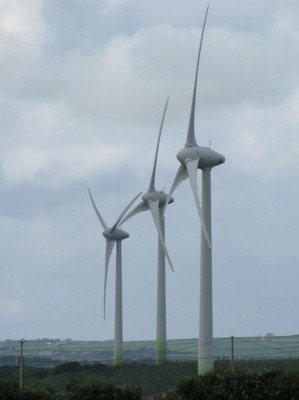I’ve always thought windmills were pretty cool. I think I just like the idea of free power. When I drove out to Los Angeles, I wanted to try and drive through one of the biggest wind farms in the country that is near there, but didn’t make it. On a windjammer cruise there was a windmill up on top of a hill of one of the islands we visited (great idea for an island since otherwise they would have to import fuel and they already have plenty of wind). When I went to Ireland, there were windmills all over the place and I took pictures and video of them. As part of the European Union, Ireland has a goal of producing 22% of its power from renewable sources which would include wind, solar, and hyro, but the biggest renewable source would be wind. They never made 22%, but they had an intermediate goal of 13.2% and in 2010, got to 11%. But since power demand and wind are not consistent, wind has sometimes supplied as much of 50% of their demand at one particular moment (probably of low demand and a nice wind).
Some of the biggest wind farms in the world are in the US. California started some massive wind farms in the 70’s that are still operating. The one near LA is called San Gorgonio Pass, with 3,218 windmills producing 615 megawatts of power. The Tehacapi Pass Wind Farm produces 705 megawatts. But the biggest concentration of windmills is the Altamont Pass with 4,930 windmills producing 576 MW. The older windmills are much smaller and produce less power each. They were trying a lot of things early on including egg beater windmills that spin no matter which way the wind is blowing, one-armed giants, and variable pitch blades that adjust to the strength of the wind and can withstand potentially damaging winds by slicing through the wind instead of catching it. The fast-spinning older windmills also made a lot of noise and kill a lot of birds.
Modern windmills are much larger with 3 blades that spin slowly, but steadily. Now the biggest windmill farms are in Texas, but they have far fewer windmills. The Roscoe wind farm in Texas produces the most power at 781 megawatts, but has only 627 windmills (looking at the area on Google earth, I saw oil wells mixed in with the windmills, and it is all farmland, serious multitasking!). Actually, it looks like California has reclaimed the biggest wind farm with its Alta Wind Energy Center, with 1020 MW capacity, with more on the way (Google financed 270 MW worth of the construction).
But how much power are they really producing? The standard unit seems to be the number of homes they can power. The Roscoe farm produces enough power for 250,000 homes. Okay fine, but how much power does a coal plant produce? There is a very large coal plant in north Georgia called Plant Bowen. It can produce 3,499 MW. That’s more than 4 times as much power as the biggest wind farm in the country, equal to 2,809 modern windmills! In reality, even though a wind farm might have 1000 MW of capacity, it will realistically only produce at 30-50% of that capacity while a coal or nuclear plant can produce at 80-90% of their capacity. But Plant Bowen is also the largest single producer of the pollutant sulfur dioxide in the entire country. And it is the fourth largest producer of carbon dioxide, a greenhouse gas.
For comparison, a single nuclear power reactor can produce 1200 MW of power (963 windmills). Georgia’s Plant Vogtle has two reactors, with two more under construction. Plant McDonough, just northwest of Atlanta on the Chattahoochee River, formerly powered by coal, will have three 840 MW plants powered by natural gas, reducing sulfur dioxide emissions by 99% and cutting the production of carbon dioxide by 50%. Buford Dam at Lake Lanier produces about 80 MW of power (only 64 windmills). On average, Georgia needs 15,000 MW of electrical power (12,042 windmills). Unfortunately, not many places in Georgia have sufficient wind for windmills to work. And wind or solar will only work for some portion of power needs since they are intermittent. One way to get more consistent operation would be to pump water back to the top of a dam when the wind is really blowing and then use that water to produce hydro power when the wind slows down.

